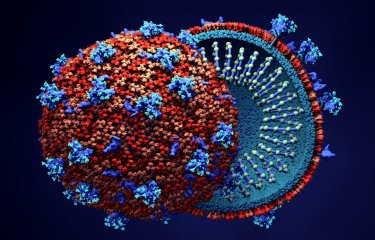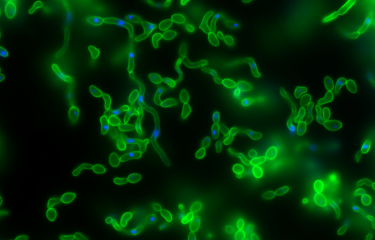Scientists studying hundreds of genome sequences of the rabies virus at the Institut Pasteur have shown that two major viral types – bat rabies and dog rabies – evolved in different ways. These genetic data provide evolutionary models that may explain transmission between one species and another.
Diseases transferred from vertebrate animals to humans represent a very real threat to human health. However, “we know relatively little about the evolutionary mechanisms that account for such cross-species transmission,” explained Cécile Troupin, from the Institut Pasteur in Paris. The rabies virus is known to have crossed several species barriers. “Studying this virus allowed us to identify the evolutionary models associated with these changes.”
Cécile Troupin and her colleagues compared 321 viral genome sequences that had been collected in 66 countries over 65 years. Their analysis showed very different evolutionary patterns between bat rabies (which affects bats and certain other carnivores) and dog rabies (which affects dogs and wild carnivores) – the latter being responsible for the majority of human rabies cases.
The data suggest that rabies sub-groups affecting bats do not evolve consistently, whereas dog rabies has evolved at a constant pace. A number of other insights into dog rabies emerge from the study:
- transmission from one host species to another would appear to be linked to multiple factors, including changes in viral amino acid sequences;
- it is unlikely that the virus would need to evolve much in order to be transmitted to a new carnivore host, which may explain its more uniform evolution and the ease with which it is transferred between non-flying animal species;
- dog rabies spread rapidly throughout the world from the fifteenth century onwards, with the development of international trade and the increase in travel between continents.
The authors stress that the wide range of host species currently infected with dog rabies is probably explained both by this historical spread resulting from human travel patterns and by the genetic mechanisms governing transmission from one host to another.
This research was conducted in connection with the PREDEMICS program, funded by the European Union and coordinated by Sylvie van der Werf and co-coordinated by Hervé Bourhy at the Institut Pasteur. The program targets the study of four types of viruses from the animal reservoir that have a high potential for human transmission in Europe. The research should provide a greater understanding of the complex mechanisms governing interactions between a virus and its host and help define the major stages in disease emergence. The key objective is to improve the prevention strategies to be put in place to fight these viral diseases.
We should remember that rabies is still a widespread disease throughout the world, and is responsible for tens of thousands of deaths each year. Rabies is most commonly transmitted by dogs. Bats carry different forms of the virus from dogs or foxes, and are the focus of particular monitoring in Europe. Vaccination is an effective tool for the prevention of rabies, but the disease is always fatal once the first clinical signs have appeared.
Source
Large-scale phylogenomic analysis reveals the complex evolutionary history of rabies virus in multiple carnivore hosts, PLOS Pathogens, december 15.
Cécile Troupin1, Laurent Dacheux1, Marion Tanguy1,2, Claude Sabeta3, Hervé Blanc4, Christiane Bouchier2, Marco Vignuzzi4, Sebastian Duchene5,6, Edward C. Holmes5, Hervé Bourhy1*
1. Institut Pasteur, Unit Lyssavirus Dynamics and Host Adaptation, WHO Collaborating Centre for Reference and Research on Rabies, Paris, France,
2. Institut Pasteur, Genomics Platform, Paris, France,
3. Agricultural Research Council, Onderstepoort Veterinary Institute, OIE Rabies Reference Laboratory, Pretoria, South Africa,
4. Institut Pasteur, Centre National de la Recherche Scientifique UMR 3569, Viral Populations and Pathogenesis Unit, Paris, France,
5. Marie Bashir Institute for Infectious Diseases and Biosecurity, Charles Perkins Centre, School of Life and Environmental Sciences and Sydney Medical School, The University of Sydney, Sydney, Australia,
6. Centre for Systems Genomics, University of Melbourne, Parkville, Victoria, Australia
Mis à jour le 15/12/2016






